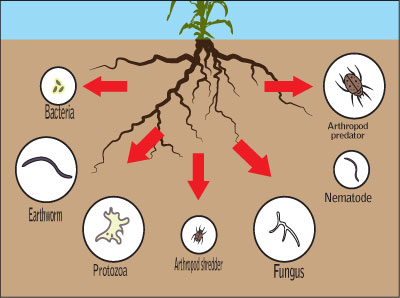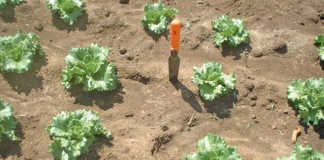Plants use an extremely efficient system called photosynthesis to feed themselves. Only about 40% of the products of photosynthesis are used by the plant to produce aerial (above-ground) parts, such as leaves, stems, and reproductive organs (flowers/fruits). The rest is sent to the plant’s root system. Here, half is used for root growth and the rest is pumped into the soil.

Figure 1: Some of the many different micro-organisms found in the soil. Courtesy of FFF
Since a plant is a highly efficient organism, we need to ask why plants would pump up to 30% of all the energy they produce into the soil surrounding their roots. The answer is shown in Figure 1, which depicts the many different micro-organisms found in the soil – from those which can be seen with the naked eye, such as earthworms, all the way down to microscopic bacteria.
Plant roots have a barter-type relationship with the bacteria in the soil. The plant feeds the bacteria sugars and, in return, is supplied with essential nutrients which it needs to grow and produce fruit. Fungi help plant roots to extend their reach. They grow to great lengths and create a complex network in the soil. Many form symbiotic relationships with plant roots and can help to transport both nutrients and water over vast distances.
Fungi also hold calcium in the soil and control pH balance. Many bacteria mineralise nutrients in parent rock material and organic matter. This means that the plant can access nutrients in an easily available form.
Foundations for Farming (FFF) is a Zimbabwe-based NGO that teaches conservation agriculture practices to farmers, based on Christian principles. FFF provided the information for this article. Visit www.foundationsforfarming.org.












